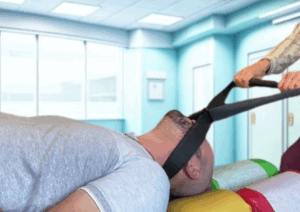The Truth About the Y-Strap Adjustment: Hype, Risk, and What You Should Know

If you’ve spent any time on TikTok or Instagram lately, you’ve probably seen viral videos of the Y-Strap Adjustment — a technique where a chiropractor places a strap around the head and gives a sudden, forceful pull along the spine. The loud cracks, dramatic reactions, and promises of instant relief make for eye-catching content. But is it actually safe? Is it necessary? And does it deliver long-term results? Let’s take a closer look.
What Is the Y-Strap Adjustment?
The Y-Strap, short for “Y-axis traction strap,” is a device used to perform a high-velocity, high-amplitude (HVHA) distraction of the spine, usually in the cervical region. The idea is to apply a quick, strong axial pull to decompress the spine — like a manual version of spinal traction therapy.
The Y-Strap technique is not new. It’s a variation of spinal decompression, which has been used in certain therapeutic settings. However, the way it’s often applied — rapid, aggressive, and without clear clinical need — raises important concerns.
What Does the Research Say?
At this stage, there is very little peer-reviewed scientific research specifically evaluating the Y-Strap. Most of the evidence supporting spinal decompression therapy comes from controlled, mechanical traction units used under specific protocols — not rapid manual yanking.
Key points from the research on spinal decompression:
– Decompression therapy using specialized devices has shown moderate evidence for short-term relief in disc herniations and nerve compression (e.g., McClure et al., 2006).
– Manual cervical traction, when applied carefully, can relieve symptoms like radiculopathy or nerve root irritation (Yoon et al., 2017).
– High-velocity traction movements (such as the Y-Strap adjustment) lack clinical trials supporting their safety or efficacy compared to slower, controlled methods.
In short: While decompression in itself has a place, the way the Y-Strap is often performed — rapidly, forcefully, and sometimes without proper evaluation — is not backed by strong scientific evidence.
Potential Risks of the Y-Strap Adjustment
Because of the forces involved, certain individuals are at higher risk of harm from this technique. Some possible complications include:
– Cervical artery dissection leading to stroke
– Facet joint irritation or damage
– Disc injury
– Worsening of spinal instability
Even if performed “safely,” the technique is aggressive, and not everyone’s anatomy or medical history is suited to tolerate that kind of force.
Contraindications to the Y-Strap
It’s crucial to understand that not everyone should even be considered for this kind of adjustment. Here’s a list of conditions that absolutely warrant caution or full avoidance:
– Osteoporosis: Brittle bones can fracture under sudden force.
– Osteopenia: Early-stage bone weakening increases risk.
– Ligamentous instability: Conditions like Ehlers-Danlos Syndrome make joints dangerously hypermobile.
– History of stroke or TIA: Risk of vascular complications is too high.
– Cervical spine instability: From previous trauma, surgery, or congenital abnormalities.
– Rheumatoid arthritis: Can cause ligament and joint destruction, especially at the cervical spine (e.g., atlantoaxial instability).
– Cancer with bone metastasis: Any malignancy affecting the spine is an absolute contraindication.
– Severe disc herniation with myelopathy: Rapid decompression could worsen neurological symptoms.
– Connective tissue disorders: Marfan syndrome, lupus, etc.
Proper screening, imaging (where appropriate), and clinical reasoning are mandatory before even considering cervical traction — let alone the Y-Strap.
Is It Ever Appropriate?
There may be rare situations where a gentle, controlled Y-axis traction could be beneficial — but those are few, far between, and would always involve:
– Careful patient selection
– Thorough clinical examination
– Informed consent
– Very cautious, non-aggressive technique
As of now, the Y-Strap, as it’s popularly performed, is more about viral marketing than medical necessity.
Clinician’s Perspective
As a chiropractor committed to evidence-based, patient-centered care, I approach techniques like the Y-Strap adjustment with caution. While it has gained popularity through viral videos, there is limited high-quality research supporting its safety or necessity. In my practice, I prioritize treatment methods that are clinically validated, tailored to each individual’s needs, and always mindful of potential risks. Techniques that involve high-velocity, high-amplitude traction on the cervical spine — especially without proper screening — are not something I routinely offer. Patient safety and sustainable outcomes will always outweigh trends or social media hype.
Ready for Safe, Evidence-Based Chiropractic Care?
Curious about chiropractic care that puts your health and safety first?
Book your consultation today at The Cape Town Chiro and experience treatment that’s built on science — not social media trends.